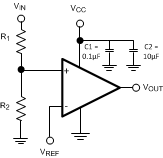SNOSA56I February 2003 – September 2015 LMV7271 , LMV7272 , LMV7275
PRODUCTION DATA.
- 1 Features
- 2 Applications
- 3 Description
- 4 Revision History
- 5 Pin Configuration and Functions
-
6 Specifications
- 6.1 Absolute Maximum Ratings
- 6.2 ESD Ratings
- 6.3 Recommended Operating Conditions
- 6.4 Thermal Information
- 6.5 1.8-V Electrical Characteristics
- 6.6 1.8-V AC Electrical Characteristics
- 6.7 2.7-V Electrical Characteristics
- 6.8 2.7-V AC Electrical Characteristics
- 6.9 5-V Electrical Characteristics
- 6.10 5-V AC Electrical Characteristics
- 6.11 Typical Characteristics
-
7 Detailed Description
- 7.1 Overview
- 7.2 Functional Block Diagram
- 7.3 Feature Description
- 7.4 Device Functional Modes
- 8 Application and Implementation
- 9 Power Supply Recommendations
- 10Layout
- 11Device and Documentation Support
- 12Mechanical, Packaging, and Orderable Information
Package Options
Mechanical Data (Package|Pins)
Thermal pad, mechanical data (Package|Pins)
Orderable Information
1 Features
- (VS = 1.8 V, TA = 25°C, Typical Values Unless Specified).
- Single or Dual Supplies
- Ultra Low Supply Current 9 µA Per Channel
- Low Input Bias Current 10 nA
- Low Input Offset Current 200 pA
- Low Ensured VOS 4 mV
- Propagation Delay 880 ns (20-mV Overdrive)
- Input Common Mode Voltage Range 0.1 V Beyond Rails
- LMV7272 is Available in DSBGA Package
2 Applications
- Wearable Devices
- Mobile Phones and Tablets
- Battery-Powered Electronics
- General Purpose Low Voltage Applications
3 Description
The LMV727x devices are rail-to-rail input low power comparators, characterized at supply voltages 1.8 V, 2.7 V, and 5 V. They consume as little as 9-uA supply current per channel while achieving a 800-ns propagation delay.
The LMV7271 and LMV7275 (single) are available in SC70 and SOT-23 packages. The LMV7272 (dual) is available in the DSBGA package. With these tiny packages, the PCB area can be significantly reduced. They are ideal for low voltage, low power, and space-critical designs.
The LMV7271 and LMV7272 both feature a push-pull output stage which allows operation with minimum power consumption when driving a load.
The LMV7275 features an open-drain output stage that allows for wired-OR configurations. The open-drain output also offers the advantage of allowing the output to be pulled to any voltage up to 5.5 V, regardless of the supply voltage of the LMV7275, which is useful for level-shifting applications.
The LMV727x devices are built with Texas Instruments' advance submicron silicon-gate BiCMOS process. They all have bipolar inputs for improved noise performance, and CMOS outputs for rail-to-rail output swing.
Device Information(1)
| PART NUMBER | PACKAGE | BODY SIZE (NOM) |
|---|---|---|
| LMV7271, LMV7275 |
SC70 (5) | 1.25 mm × 2.00 mm |
| SOT-23 (5) | 1.60 mm × 2.90 mm | |
| LMV7272 | DSBGA (8) | 1.50 mm x 1.50 mm |
- For all available packages, see the orderable addendum at the end of the data sheet.
Typical Circuit
